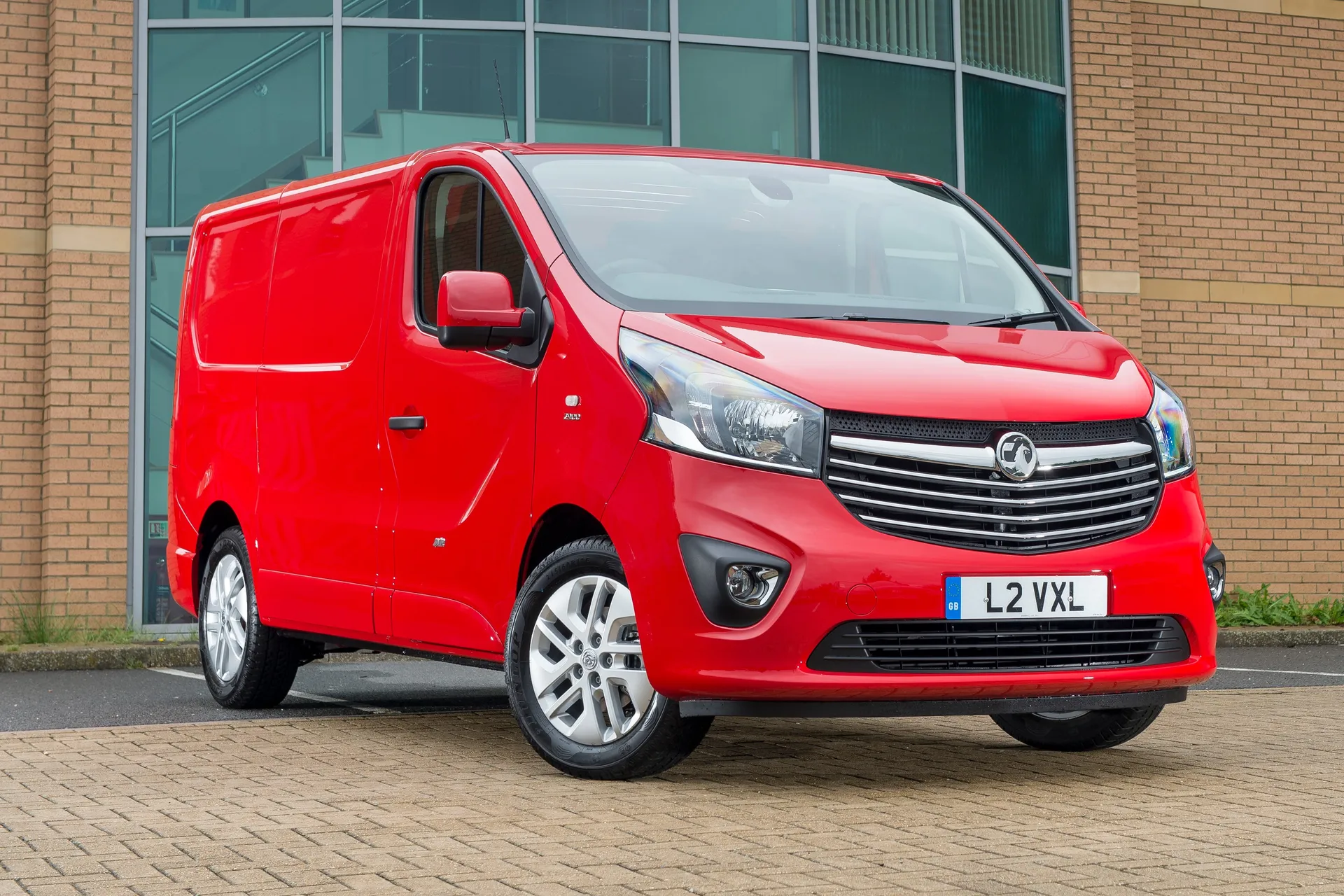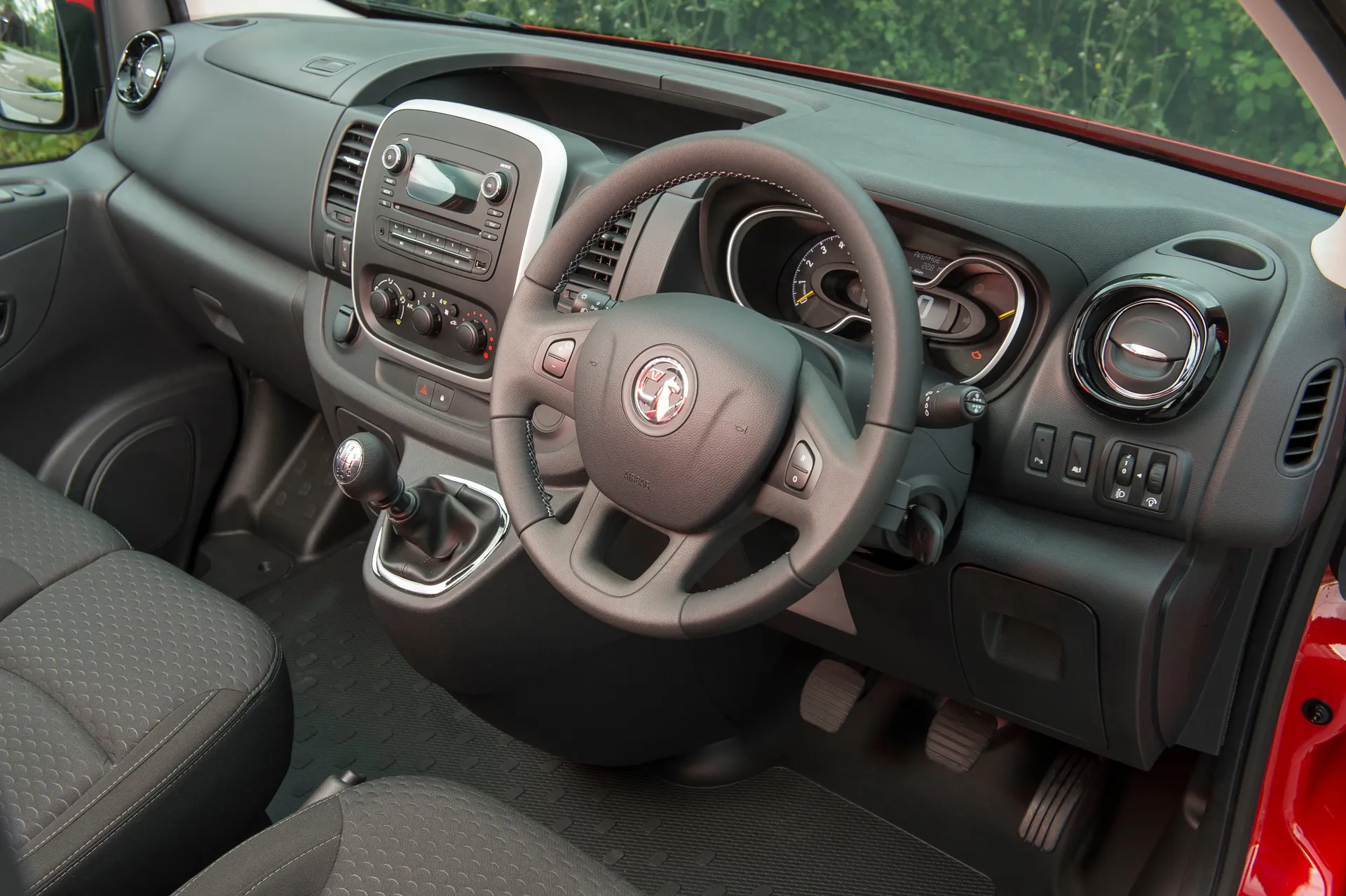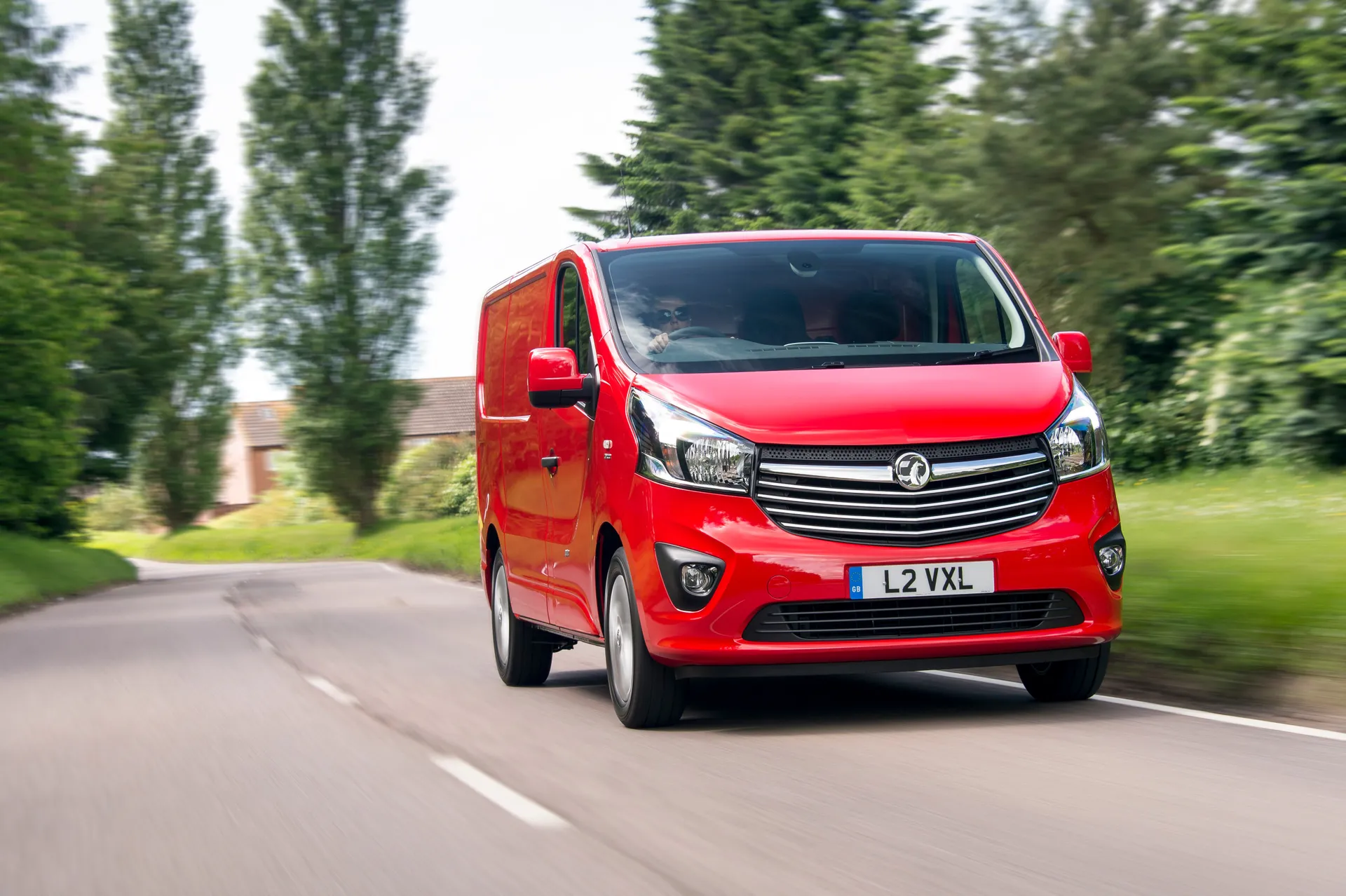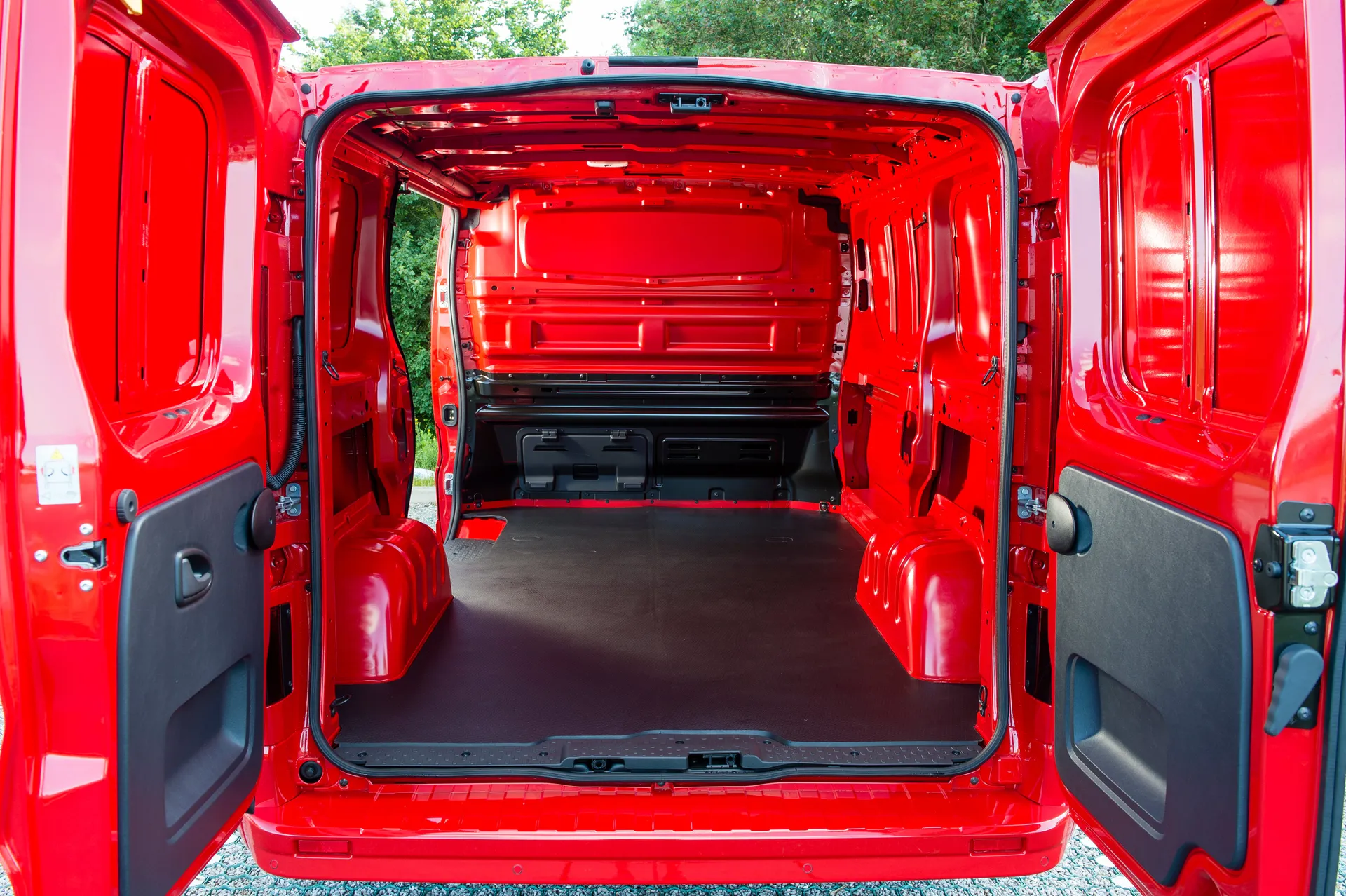Vauxhall Vivaro (2014-2019) Review
Quick overview
Pros
- Strong, refined 1.6-litre diesel engines
- Standard-fit digital radio
- Excellent and well-controlled ride
Cons
- Dated technology offering
- Naff design details on range-topping version
- Not the best payload in the class
Overall verdict
"This means this generation of Vivaro, which shared its platform and major parts with the Renault Trafic and Fiat Talento, bears little resemblance to the model that replaced it."

The 2014-2019 Vivaro was a popular van that was a regular feature towards the top of the sales charts. As well as being a solid and dependable van that was good to drive, it offered a wide range of body shapes and sizes and a trim range that featured everything from a utilitarian base model up to well-appointed editions that came with loads of equipment.
The engines were all 1.6-litre diesels from launch until the time the model went off sale, although they were updated in 2016 when they received a tweak to match up to Euro 6 emissions standards. Two of the four engines were single-turbo units with 90PS and 115PS while the other two were Biturbo engines with 120PS and 140PS. The 2016 update brought each version a 5PS update, although the torque ratings remained the same across the range.
The most efficient is the lower powered of the two Biturbo engines, which offers a 47.0mpg official fuel economy rating, although it’s worth bearing in mind that is on the now-replaced NEDC fuel testing procedure.
When it came to the load space, Vauxhall kept things largely unchanged over the previous version, which meant that customers could move over the internal racking and fixtures from their old van. There are two lengths of Vivaro, and two different heights. This means that there is a relatively wide selection of different sizes, with cargo areas ranging from 5.2 cubic metres up to 8.6 cubic metres. Even the shortest L1 model is capable of taking three Euro pallets and there is also a handy load-through bulkhead, called the Flex Cargo, which allows you to slot longer items into the cabin on the passenger side.
The interior was upgraded notably over the previous generation of Vivaro, with lots of handy and practical touches. The laptop storage bin and plentiful cubby holes are particularly useful. The mobile phone cradle up on the dash is a great idea but has been rendered useless for many because of how much handsets have grown in recent years – it’s too small for many modern mobiles.
As well as the base model, there is a Sportive version and a Limited Edition Nav, which comes with a load of kit including navigation, automatic lights and wipers and some eye-catching graphics that might not be to everyone’s taste – they look a little like a rather outdated tribal tattoo.
The Vivaro is an impressive van to drive, with relatively light steering, a quiet cabin and suspension that is really composed, even over rough surfaces. The Vivaro might not have been perfect but it certainly justified its popularity in many varied senses.
Looking for a used van for sale? We've got 100s of Vauxhall Approved Used Cars for Sale for you to choose from, including a wide range of Vauxhall Vivaro vans for sale. If you're looking for the newer version, you need our Vauxhall Vivaro review.
Is the Vauxhall Vivaro 2014-2019 right for you?
The Vivaro has been the right van for many people, for many reasons. It has a strong selection of engines that are quiet and refined, and it offers a good range of different body shapes where rivals don’t. The Citroen Dispatch and Peugeot Expert, for example, only come with one height while the Vivaro’s two heights mean it is more things to more people.
If you’re after a van that is solid, spacious and good to drive then the Vivaro ticks pretty much all the boxes on your wish list. It might not be quite as sharp to drive as the Ford Transit Custom, and age hasn’t been kind to some of the features in the cabin, like the phone holder, but it is economical and rides well.
What’s the best Vauxhall Vivaro model/engine to choose?
There are multiple reasons to pick the Biturbo engines over the single-turbo equivalents. For one, they offer a little more boost lower down, which means that they have a fast throttle response, but the second reason is their superior economy.
There is little reason to go for the range-topping Limited Edition Nav over the Sportive – most of the equipment is either cosmetic or doesn’t really justify the step up. The Sportive comes with the important stuff, though, like the load-through hatch, parking sensors, air conditioning and extra cabin storage.
The entry-level model is really aimed at the sort of fleets that would buy in bulk and comes across as a bit basic. If you are choosing a van for yourself, treat yourself to at least a couple of luxuries.
What other cars are similar to the Vauxhall Vivaro?
What cars are similar and what competes even if it’s not in the same class (i.e if value is your priority also consider, same for other areas, e.g warranty, space, performance, etc)
The closest vans to the Vauxhall Vivaro are the Fiat Talento, Nissan NV300 and Renault Trafic – the four are all based on the same platform and share the same engines so the difference only really comes down to packaging and design tweaks. The Trafic, for example, offers a slightly longer warranty with the latest versions coming with five years’ cover.
The big contender in the Vivaro’s class is the Ford Transit Custom, which is regularly the biggest selling van in the country by some distance. It provides a slightly sharper drive and the most recent versions have a classier cabin. If you want a van that offers a little more in the way of a car-like feel inside then the Volkswagen Transporter is another to consider.
Comfort and design
"The seating in the Vivaro is excellent and, best of all, the wide range of adjustment comes on all models as standard. This means that you get six-way adjustment, lumbar support and an arm rest on every model."

Vauxhall listened to feedback from drivers and tweaked the design of the bulkhead so that the seat can be tilted back even when you have it all the way back as far as it can go, which is more than can be said for rivals like the Peugeot Expert and Citroen Dispatch.
If you go for the dual front passenger seat, as many will because there is enough room to carry three across the front, you don’t get much adjustment on the passenger seat – the seat back is fixed. However, you could get a version with two seats as an optional extra, which gets just as much adjustment as the driver’s seat.
The dashboard is beautiful in its simplicity, with the instrument cluster dominated by a large digital speedometer that makes it really easy to stick to speed limits in town. The rest of the dash features big chunky dials and buttons that are easy to see and stab while on the move, meaning you can adjust the temperature and fans without taking your eyes off the road. The exception is the stereo, which has some fiddly controls.
The gear lever is set high up on the dash without dominating, and is positioned so it is easy to reach without moving your hand too far from the steering wheel. The manual hand brake is a little lower down, though, and is tucked in between the two front seats. Popping it on and off in traffic might feel a little wearing after a while.
Quality and finish
The quality inside the Vivaro is generally good, with the various bits feeling well screwed together. There are, as there tends to be on vans, a large amount of hard plastics throughout the cabin. These are designed to help deal with the sort of hard-working life that a van goes through, but it does mean that the cabin feels a little utilitarian in places. There are a couple of exceptions, though, such as the glovebox. The lid feels a little lightweight and it can’t be locked, which is a shame.
The big difference between the lower trims and the range-topping Limited Edition Nav is the addition of the seven-inch touchscreen.
There aren’t many stylistic flourishes as you head up the range – every version gets a leather-covered steering wheel – but the Sportive and Limited Edition Nav get a different seat upholstery. None get leather as standard, but the Vivaro was a bit of a rarity in that you could specify leather as an option.
Infotainment
The Vivaro was ahead of some rivals at the time of its launch by offering digital radio as standard on all models, alongside Bluetooth, USB and aux connections.
Every version also comes with steering-wheel mounted controls as standard, which can be used to control the hands-free phone – a bonus for those who might be fielding calls from the boss.
Unusually for a van, there are two satellite navigation systems. One comes as standard on the Limited Edition Nav version, and there is another version with live traffic updates. However, the updates service ends on 31 December 2020 and can’t be renewed, so the basic model will work just as well. Even before that happens the system feels a little dated by modern standards. It is straightforward to operate and has clear graphics, though. Because of its age, there is no Apple Carplay or Android Auto available.
Space and practicality
The majority of Vivaros will have three seats across the front of the cabin – there was the option to turn it into a two-seater, but few will have willingly reduced the number of people that can fit into a work vehicle.
The space for the two passengers in the front is not too bad, but could be a little better. The far passenger seat is wide enough and there is plenty of space if you aren’t carrying anyone in the middle. There is loads of legroom for example and there is a good amount of headroom for all three. The middle seat is a bit narrow and uncomfortable on anything other than shorter journeys.
The combi versions have space for up to eight in three rows of seats. The double cab has space for five, with only space for the one front passenger.
All models apart from the basic one come with the Flex Cargo load-through hatch on the passenger side which extends the load length up to a maximum of 4.15m in the longer of the two models.
The interior space is good, and aided by the wide range of body shapes that the Vivaro comes in. Even the shortest L1 version can carry three Euro pallets and there are up to 20 lashing points around the loading bay. The total loading capacity ranges from 5.2 cubic metres to 8.6 cubic metres, which is notably more than the Peugeot Expert and Citroen Dispatch – the models on which the latest Vivaro is based.
The basic model comes with solid twin rear doors that open out to 180 degrees, although this could be extended out to 270 degrees on the L2 version. The options list also allowed you to spec side-hinged doors with windows or a top-hinged tailgate.
The payloads in the Vivaro are good but not class leading. The fact that every model can carry more than 1000kg is good, but the top level of 1281kg is more than 100kg short of the best in class.
Handling and ride quality
"The Vivaro was a van that took big strides towards offering a car-like driving experience, upping its game versus the version that immediately preceded it."

The large mirrors with extra wide-angle lenses to see into the blind-spot are very handy, while there is an extra wide-angle mirror built into the passenger sun visor. It can wobble a bit but it stays stable enough to show you if there is anything out of normal sight on your passenger side.
The Vivaro’s suspension is one of its most impressive assets, with a ride that is smooth and composed over a wide range of surfaces. It deals wonderfully with poor road surfaces, even when it doesn’t have anything in the back to settle the suspension down.
Even though it offers this level of comfort it is still really composed when it comes to cornering, even at higher speeds. This is an impressive van to drive, and is arguably one of the benchmarks in the class – right up with the even more impressive Ford Transit Custom.
The steering is nice and light at lower speeds, which helps no end with town manoeuvres, but it gives a reassuring amount of resistance at higher speeds to help it hold its line on the motorway.
Another handy asset is the standard fitment of hill start assist. There is no four-wheel drive version of the Vivaro, though, and no version with any added cladding or underbody protection – this is a van designed for the road and less rugged building sites at best.
Engines and gearboxes
The engine range in the Vivaro consisted of 1.6-litre diesels throughout its life, although there was a slight tweak to four units in 2016.
When it was launched in 2014, the Vivaro’s engines consisted of two single-turbo 1.6-litre engines with 90PS and 115PS. The lower powered version is the town model, but the higher of these two has enough torque at 300Nm to pull strongly without ever feeling flustered.
The other two engines were both dubbed Biturbos, which meant they had two turbochargers, and offered 120PS and 140PS. Because the smaller of the two turbochargers kicks in at lower revs, there is more urgency from lower in the rev range so it feels swifter when you put your foot down. The second turbocharger then kicks in when the revs are up to boost power. They offer 320Nm and 340Nm and are the better all-round choice if you are likely to max out the payload or want to use the Vivaro for towing.
The 2016 update meant very little on a tangible basis – it was to ensure that the engines met Euro 6 emissions standards – but it did bring a power boost of 5PS to each model. Don’t expect to find that making any difference to how they perform in the real world though.
The Vivaro offered no choice at all when it came to gearboxes – you get a light and slick six-speed ‘box and that was it. Automatic wasn’t even an option.
Refinement and noise levels
Anyone upgrading from the previous Vivaro to this model will be struck by the noise, or lack of it. The 1.6-litre engines are impressively smooth and quiet, regardless of which power version you go for. The higher power Biturbos are marginally quieter even, largely because they don’t have to work as hard, but none of the range is what you would call noisy.
The vibration levels are kept to an impressively low level, too, with the engines smooth and little movement coming through the usual spots such as the gear lever and pedals.
At times the suspension can sound a little noisy, but that is largely because the wind, road and engine noise is kept out so well. This is one of the most impressive vans in the class for refinement, which makes a big difference at the end of a long drive. Not only can you hold a conversation at normal levels, you don’t get out feeling like your senses have been assaulted.
Safety equipment
The basic model’s safety kit, as ever with a van, is fairly simple on the Vivaro. It comes with just a driver’s airbag, ABS, emergency brake assist, hill start assist, a full-height steel bulkhead and an immobiliser.
Step up to Sportive and you get a couple more features, like cruise control with a speed limiter and rear parking sensors, but the Limited Edition Nav doesn’t add much more. Hit the options list and you can add passenger and side airbags, a tyre pressure monitoring system (this is included on the Combi model) a rear-view camera and a factory-fitted speed limiter that can’t be controlled by the driver.
All get a full-size spare wheel, but it’s worth checking if one is included – you could replace that with a tyre inflation kit as a no-cost option.
The Vivaro panel van wasn’t tested by Euro NCAP, but they did assess the passenger version of the mechanically identical Renault Trafic. Even with a few more pieces of equipment as standard, the Trafic only scored three stars in 2015.
MPG and fuel costs
"Because they are all similar versions of the same basic unit, the Vauxhall Vivaro’s engines are all relatively close to one another in terms of efficiency. The most efficient version is the 125PS Biturbo engine, which claims 47.0mpg."

Partly because of the engines they come with, every version manages an official average in excess of 40mpg – this is helped by the fact that the tallest/longest model only comes with that Biturbo engine.
It comes with an Eco button that dulls the throttle response and makes the van slower, too, to help you drive it more economically.
These figures might not be the best in the class, but the Vivaro has typically performed fairly well in relation to them, even though they are based on the old NEDC test. Something around 80-85% of the figure should be realistic, so mid 30s to 40mpg should be achievable.
Insurance groups and costs
The Vivaro’s insurance groups are the older 1-20 group system and the vast majority of the range sits in group 9E. The only exceptions to this are the Biturbo versions of the L2H1 model in panel van and crew van versions. The Sportive models up the rating by another group to 11E but none go much higher than that.
VED car tax
Taxing the Vivaro is the same whichever model you go for – it qualifies for the commercial vehicle VED and benefit-in-kind systems. This means a low-level, flat rate charge applies so it is much cheaper to tax than a similarly emitting car.
Trim levels and standard equipment
"The basic level of Vivaro is aimed at the sort of buyer that orders an entire fleet of vans and doesn’t worry too much about luxury."

Far better to go for the mid-level Sportive model and enjoy the extra kit it comes with, above all the Flex Cargo that lets you load longer items through into the front part of the cab. That said, air conditioning, parking sensors, cruise control, front fog lights and body coloured bumpers will all come in handy too.
The Biturbo engines are the strongest of the range to go for. The lower-powered version is the pick of the two for various reasons, chief of all economy. It is the most efficient of the range and has plenty of power and torque to cope with a fully laden cargo bay.
Get our latest advice, news and offers
Keep me updated by email with the latest advice, news and offers from heycar.
By submitting you agree to our privacy policy



